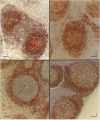Abstract
Commercially-available monoclonal antibodies to B lymphocytes were evaluated for immunohistochemical staining of feline B lymphocytes in frozen and formalin-fixed, paraffin-embedded tissues using an avidin biotin complex immunoperoxidase immunohistochemical technique. Three monoclonal antibodies: F46A and F72A raised to "carnivore" B lymphocytes and RA3.6B2 raised to murine B lymphocytes, stained B lymphocyte-dependent areas of frozen feline lymphoid tissue. In addition, antibody RA3.6B2 stained B lymphocyte dependent areas in formalin-fixed, paraffin-embedded feline tissues. There was no staining of T lymphocyte-dependent areas in either frozen or formalin-fixed tissues. Dual parameter flow cytometry, using an anti-pan-T lymphocyte antibody, revealed that greater than 99% of the cells stained by RA3.6B2 are a population distinct from T lymphocytes. F46A was shown to stain a sub-population of those cells stained with RA3.6B2. These antibodies may be useful in the identification of feline B lymphocytes using immunohistochemistry and flow cytometry and thereby provide additional tools to study B lymphocyte ontogeny and the significance of lymphocyte phenotype in lymphoid neoplasia in cats.
Full text
PDF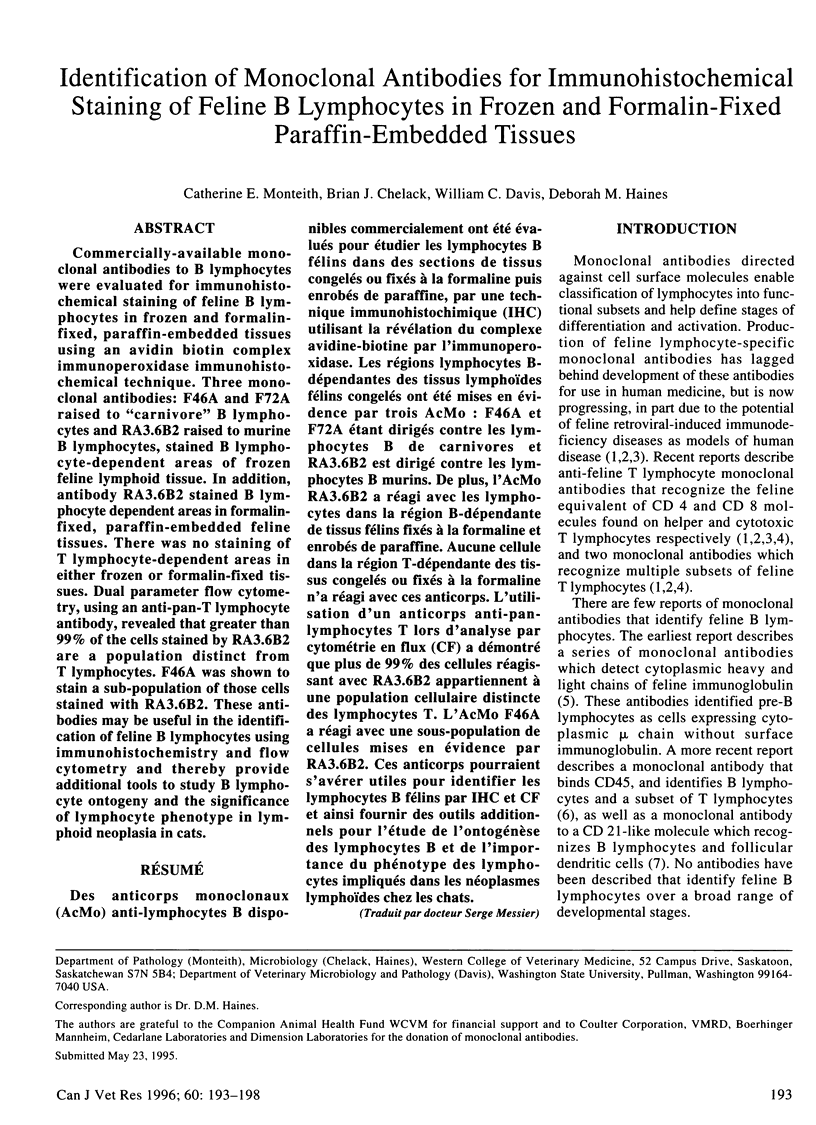
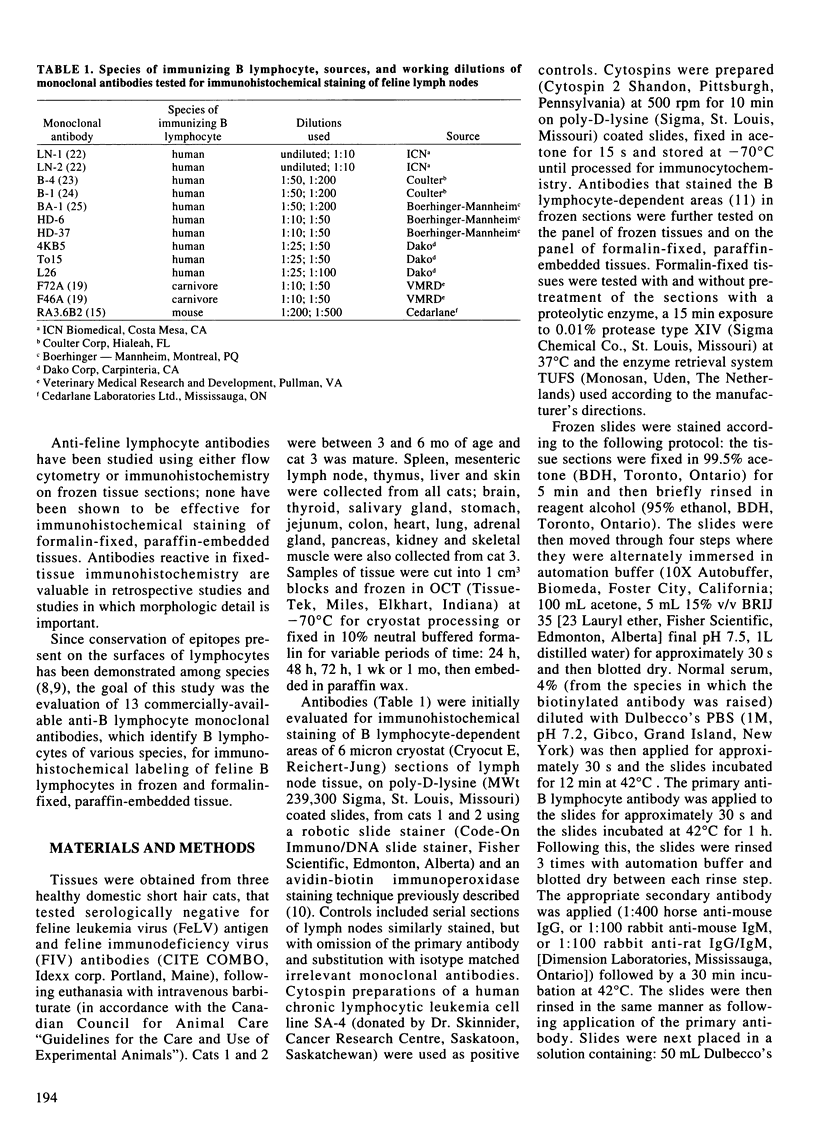
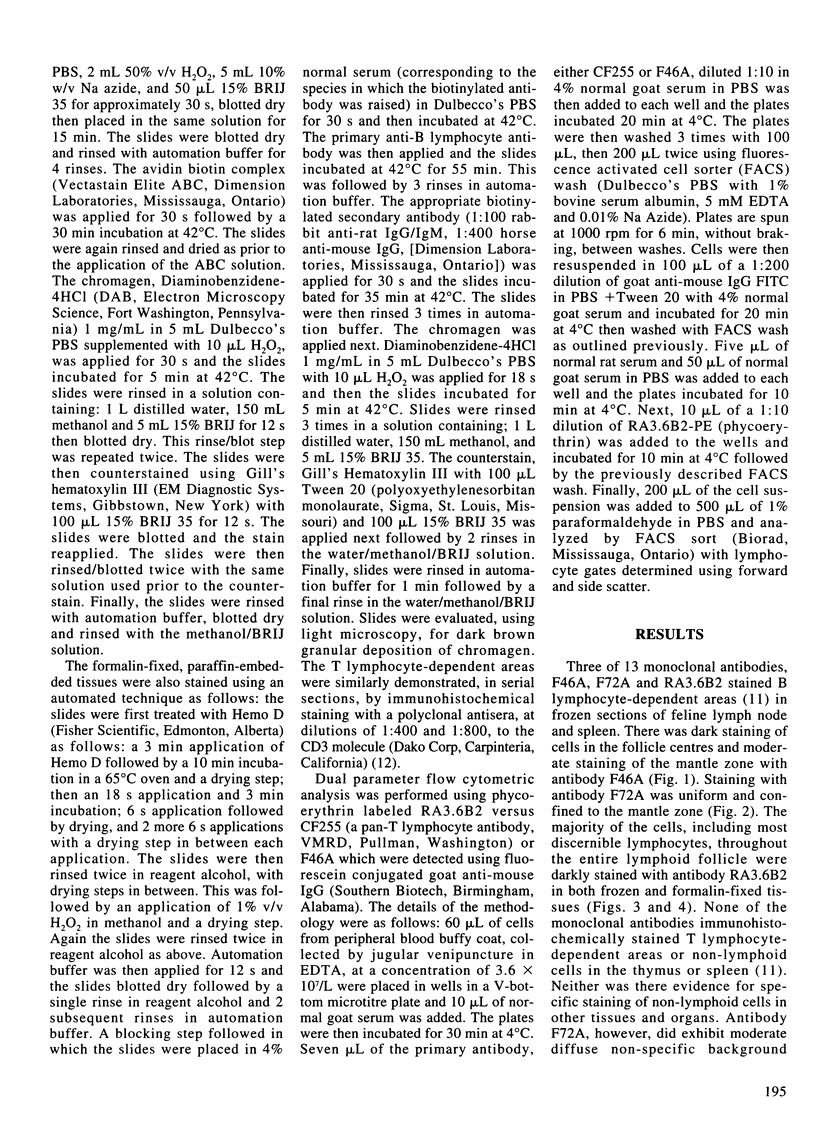
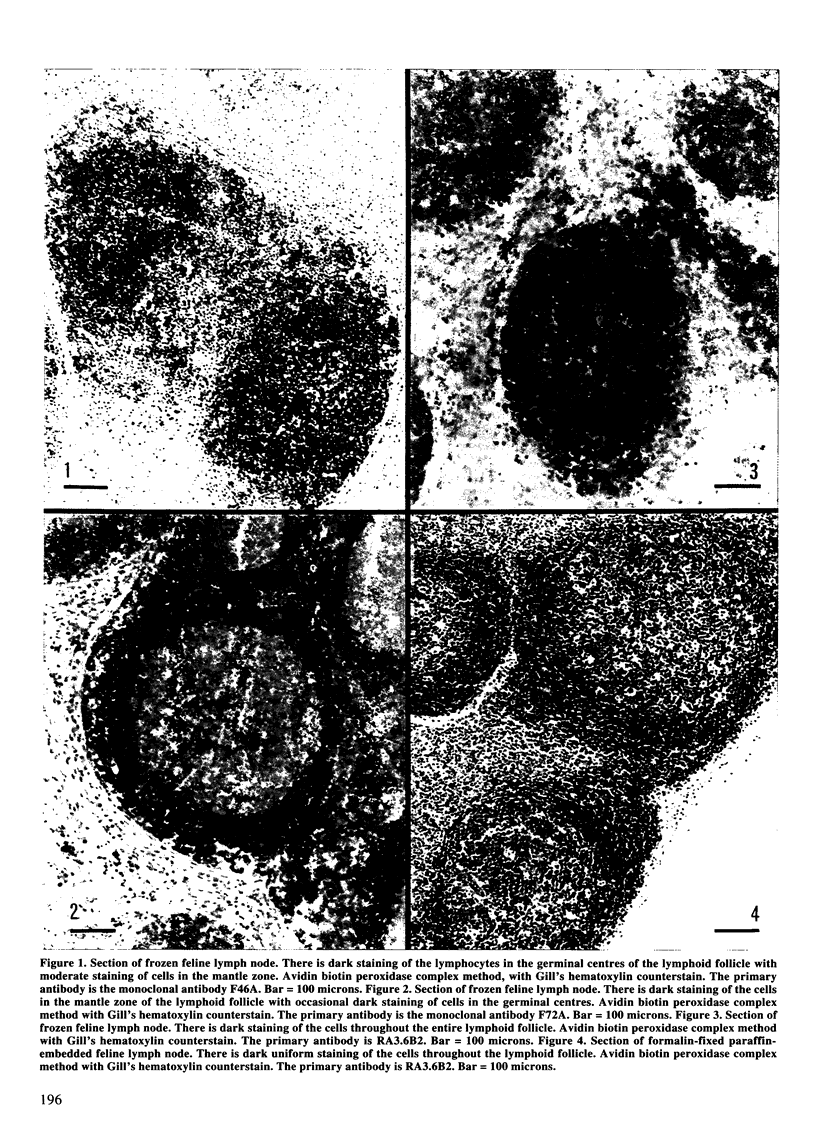
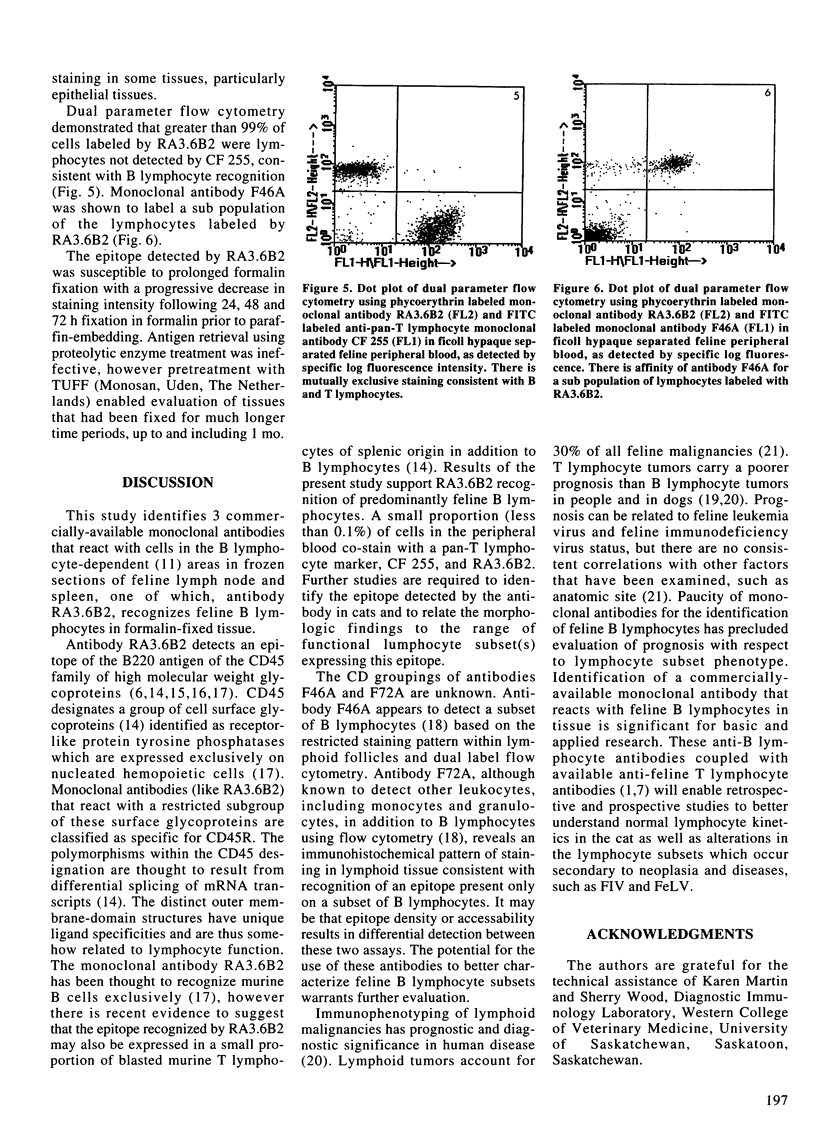
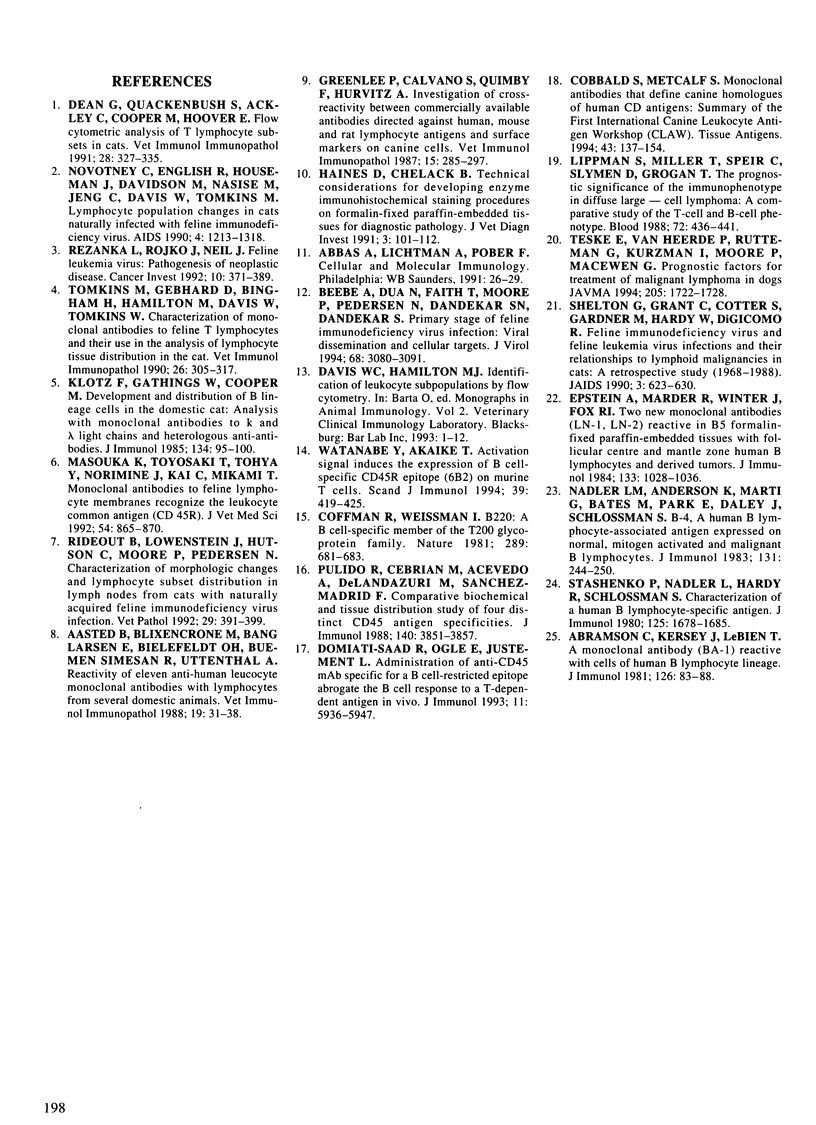
Images in this article
Selected References
These references are in PubMed. This may not be the complete list of references from this article.
- Aasted B., Blixenkrone-Møller M., Larsen E. B., Bielefeldt Ohmann H., Simesen R. B., Uttenthal A. Reactivity of eleven anti-human leucocyte monoclonal antibodies with lymphocytes from several domestic animals. Vet Immunol Immunopathol. 1988 Jul;19(1):31–38. doi: 10.1016/0165-2427(88)90044-x. [DOI] [PubMed] [Google Scholar]
- Abramson C. S., Kersey J. H., LeBien T. W. A monoclonal antibody (BA-1) reactive with cells of human B lymphocyte lineage. J Immunol. 1981 Jan;126(1):83–88. [PubMed] [Google Scholar]
- Beebe A. M., Dua N., Faith T. G., Moore P. F., Pedersen N. C., Dandekar S. Primary stage of feline immunodeficiency virus infection: viral dissemination and cellular targets. J Virol. 1994 May;68(5):3080–3091. doi: 10.1128/jvi.68.5.3080-3091.1994. [DOI] [PMC free article] [PubMed] [Google Scholar]
- Cobbold S., Metcalfe S. Monoclonal antibodies that define canine homologues of human CD antigens: summary of the First International Canine Leukocyte Antigen Workshop (CLAW). Tissue Antigens. 1994 Mar;43(3):137–154. doi: 10.1111/j.1399-0039.1994.tb02315.x. [DOI] [PubMed] [Google Scholar]
- Coffman R. L., Weissman I. L. B220: a B cell-specific member of th T200 glycoprotein family. Nature. 1981 Feb 19;289(5799):681–683. doi: 10.1038/289681a0. [DOI] [PubMed] [Google Scholar]
- Dean G. A., Quackenbush S. L., Ackley C. D., Cooper M. D., Hoover E. A. Flow cytometric analysis of T-lymphocyte subsets in cats. Vet Immunol Immunopathol. 1991 Jul;28(3-4):327–335. doi: 10.1016/0165-2427(91)90124-u. [DOI] [PubMed] [Google Scholar]
- Domiati-Saad R., Ogle E. W., Justement L. B. Administration of anti-CD45 mAb specific for a B cell-restricted epitope abrogates the B cell response to a T-dependent antigen in vivo. J Immunol. 1993 Dec 1;151(11):5936–5947. [PubMed] [Google Scholar]
- Epstein A. L., Marder R. J., Winter J. N., Fox R. I. Two new monoclonal antibodies (LN-1, LN-2) reactive in B5 formalin-fixed, paraffin-embedded tissues with follicular center and mantle zone human B lymphocytes and derived tumors. J Immunol. 1984 Aug;133(2):1028–1036. [PubMed] [Google Scholar]
- Greenlee P. G., Calvano S. E., Quimby F. W., Hurvitz A. I. Investigation of cross-reactivity between commercially available antibodies directed against human, mouse, and rat lymphocyte surface antigens and surface markers on canine cells. Vet Immunol Immunopathol. 1987 Jul;15(4):285–296. doi: 10.1016/0165-2427(87)90001-8. [DOI] [PubMed] [Google Scholar]
- Haines D. M., Chelack B. J. Technical considerations for developing enzyme immunohistochemical staining procedures on formalin-fixed paraffin-embedded tissues for diagnostic pathology. J Vet Diagn Invest. 1991 Jan;3(1):101–112. doi: 10.1177/104063879100300128. [DOI] [PubMed] [Google Scholar]
- Klotz F. W., Gathings W. E., Cooper M. D. Development and distribution of B lineage cells in the domestic cat: analysis with monoclonal antibodies to cat mu-, gamma-, kappa-, and lambda-chains and heterologous anti-alpha antibodies. J Immunol. 1985 Jan;134(1):95–100. [PubMed] [Google Scholar]
- Lippman S. M., Miller T. P., Spier C. M., Slymen D. J., Grogan T. M. The prognostic significance of the immunotype in diffuse large-cell lymphoma: a comparative study of the T-cell and B-cell phenotype. Blood. 1988 Aug;72(2):436–441. [PubMed] [Google Scholar]
- Masuoka K., Toyosaki T., Tohya Y., Norimine J., Kai C., Mikami T. Monoclonal antibodies to feline lymphocyte membranes recognize the leukocyte-common antigen (CD45R). J Vet Med Sci. 1992 Oct;54(5):865–870. doi: 10.1292/jvms.54.865. [DOI] [PubMed] [Google Scholar]
- Nadler L. M., Anderson K. C., Marti G., Bates M., Park E., Daley J. F., Schlossman S. F. B4, a human B lymphocyte-associated antigen expressed on normal, mitogen-activated, and malignant B lymphocytes. J Immunol. 1983 Jul;131(1):244–250. [PubMed] [Google Scholar]
- Novotney C., English R. V., Housman J., Davidson M. G., Nasisse M. P., Jeng C. R., Davis W. C., Tompkins M. B. Lymphocyte population changes in cats naturally infected with feline immunodeficiency virus. AIDS. 1990 Dec;4(12):1213–1218. doi: 10.1097/00002030-199012000-00005. [DOI] [PubMed] [Google Scholar]
- Pulido R., Cebrián M., Acevedo A., de Landázuri M. O., Sánchez-Madrid F. Comparative biochemical and tissue distribution study of four distinct CD45 antigen specificities. J Immunol. 1988 Jun 1;140(11):3851–3857. [PubMed] [Google Scholar]
- Rezanka L. J., Rojko J. L., Neil J. C. Feline leukemia virus: pathogenesis of neoplastic disease. Cancer Invest. 1992;10(5):371–389. doi: 10.3109/07357909209024796. [DOI] [PubMed] [Google Scholar]
- Rideout B. A., Lowensteine L. J., Hutson C. A., Moore P. F., Pedersen N. C. Characterization of morphologic changes and lymphocyte subset distribution in lymph nodes from cats with naturally acquired feline immunodeficiency virus infection. Vet Pathol. 1992 Sep;29(5):391–399. doi: 10.1177/030098589202900504. [DOI] [PubMed] [Google Scholar]
- Shelton G. H., Grant C. K., Cotter S. M., Gardner M. B., Hardy W. D., Jr, DiGiacomo R. F. Feline immunodeficiency virus and feline leukemia virus infections and their relationships to lymphoid malignancies in cats: a retrospective study (1968-1988). J Acquir Immune Defic Syndr. 1990;3(6):623–630. [PubMed] [Google Scholar]
- Stashenko P., Nadler L. M., Hardy R., Schlossman S. F. Characterization of a human B lymphocyte-specific antigen. J Immunol. 1980 Oct;125(4):1678–1685. [PubMed] [Google Scholar]
- Teske E., van Heerde P., Rutteman G. R., Kurzman I. D., Moore P. F., MacEwen E. G. Prognostic factors for treatment of malignant lymphoma in dogs. J Am Vet Med Assoc. 1994 Dec 15;205(12):1722–1728. [PubMed] [Google Scholar]
- Tompkins M. B., Gebhard D. H., Bingham H. R., Hamilton M. J., Davis W. C., Tompkins W. A. Characterization of monoclonal antibodies to feline T lymphocytes and their use in the analysis of lymphocyte tissue distribution in the cat. Vet Immunol Immunopathol. 1990 Dec;26(4):305–317. doi: 10.1016/0165-2427(90)90115-9. [DOI] [PubMed] [Google Scholar]
- Watanabe Y., Akaike T. Activation signal induces the expression of B cell-specific CD45R epitope (6B2) on murine T cells. Scand J Immunol. 1994 May;39(5):419–425. doi: 10.1111/j.1365-3083.1994.tb03395.x. [DOI] [PubMed] [Google Scholar]



